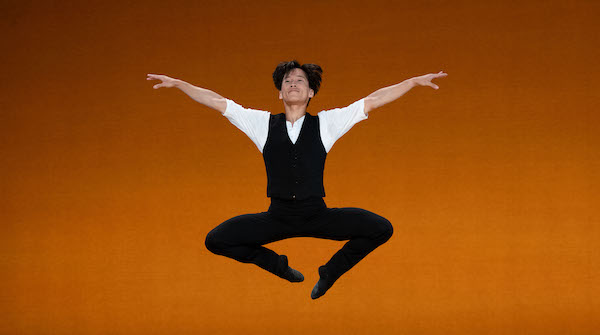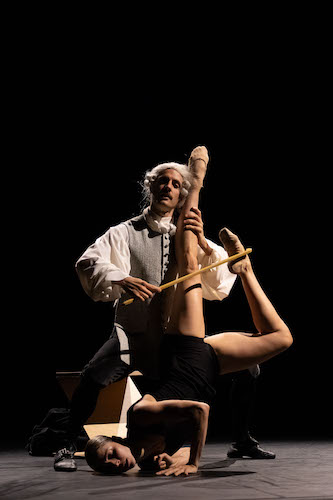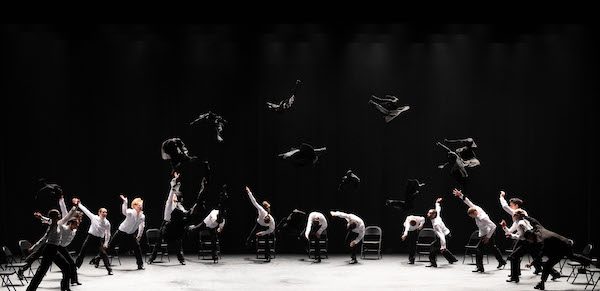Dance Review: At Jacob’s Pillow — Gauthier Dance//Dance Company Theaterhaus Stuttgart
By Charles Giuliano
The company is notable for its precision, charisma, and the calculated chaos created by sui generis Israeli choreographer Ohad Naharin.

Shori Yamamoto performing “ABC,” with Gauthier Dance//Dance Company Theaterhaus Stuttgart, in the 2023 Jacob’s Pillow Dance Festival. Photo by Christopher Duggan
Now 47, the French Canadian dancer, artistic director, and choreographer Eric Gauthier joined Stuttgart Ballet in 1996, where he rose to the rank of soloist. Initially with six dancers, in 2007 he founded Gauthier Dance//Dance Company Theaterhaus Stuttgart.
Delayed by Covid the company of 16 dancers has visited Jacob’s Pillow for the third time on the occasion of its 15th anniversary. The company is notable for its precision, charisma, and the calculated chaos created by Israeli master Ohad Naharin’s Gaga technique of liberation, movement, and self discovery. His “Minus 16” (1999) comprised the second half of the program. The first included works by Israeli choreographers Sharon Eyal and Hofesh Shechter.

Luca Pannacci and Bruna Andrade performing “Violoncello,” with Gauthier Dance//Dance Company Theaterhaus Stuttgart, in the 2023 Jacob’s Pillow Dance Festival. Photo: Christopher Duggan
The performance commenced with a pithy, provocative work, Spanish choreographer Nacho Duato’s “Violoncello” (1999). Dressed to evoke Johann Sebastian Bach, the composer “plays” a dancer as his cello. The music is a two and a half minute movement from a Bach suite for unaccompanied cello.
She is lured in to sit on his knee. Her body expresses the music as she pivots with arabesques away from him, only to become ensnared. The drama resonates with intimate eroticism as she appears to resist his aggression. The struggle ends with her seeming to succumb.
Gauthier’s sole work in the program, “ABC” (2019), is deliciously interpreted by Shori Yamamoto. Following the format of the children’s game rhyme “A, My Name Is Alice,” the piece playfully ambles through the lexicon of ballet positions. This morphs quickly into something more complex, with Yamamoto providing flashes of what the terms signify by combining dance and related words. Some letters suggest a number of words: others not so many. A, for example, is for angles, ass, amazing, Agon, Ailey, alcohol, adagio, arabesque, and allegro. The dancer supplies plenty of quick humor: he mimes “old” via a grimace and an aching back.
A mandate for the company is to present challenging choreography as well as commissioned new work. During his opening remarks, Gauthier described Stuttgart audiences as among the most sophisticated and knowledgeable in the world. He went on to rave about receiving similar receptions at the Pillow.
One of the company’s projects was to ask choreographers to take on the Seven Deadly Sins. Sharon Eyal’s “Point” (2022) took on the sin of envy. It is danced by Bruna Andrade, Izabela Szylinska, and Karljin Dedroog. The women are in white, dressed in leotards and tights. The look amplifies the glacial feeling of the movement, which is mechanical, clear, cool, and redolent of sangfroid.
Two women were grouped on one side with an achingly wide gap maintained from the odd woman out. There is the sense of ballet méchanique as they execute perfect but emotionally detached pliés. The austere behavior of the dancers obviously signifies rejection. It reflects how — with brusque formality — we distance ourselves from others. Is this a love triangle? That guess is briefly confirmed when the couple kisses.
For another project, Gauthier commissioned five variations on “Swan Lake.” One of these is “Swan Cake” (2021) by Hofesh Shechter. As the dancers catapulted onto the stage — never wavering from flat-out assault mode — you were left flummoxed. Where were the swans? And what about the cake?
At the Pillow, Gauthier described how the thrilling and energetic piece was created during an intense but brief residence. Schechter created every part of the work, including the ragtag street-cred costumes and upbeat, extremely loud synth music. At first, the cluster of dancers appeared via seemingly free and chaotic moves. They clapped with the beat and members of the audience joined them. There followed full body movement with thrusting arms and herky jerks. One could feel the Gaga technique at play here.
During the interval a man in a black suit cavorted and mimed. Those that lingered or returned to their seats didn’t know what to make of it. It reminded me of Robert Wilson’s Knee Plays, based on Kabuki performances; they were performed between the acts. The impromptu was formalized as, one by one, the similarly attired company members joined him onstage.

The Gauthier Dance//Dance Company Theaterhaus Stuttgart performing “Swan Cake” in the 2023 Jacob’s Pillow Dance Festival. Photo by Christopher Duggan
The curtain closed, then reopened with a semicircle of 16 performers garbed as Orthodox Jews with broad-brimmed hats and black suits with white shirts. About this work, Gautier commented that he had finally found the 16 dancers required to performer Ohad Naharin’s masterpiece “Minus 16” (1999).
The Bathsheva Dance Company made its Pillow debut in 1995 and returned in 2004. In 2018, Naharin performed with The Young Ensemble, which introduced our region to the remarkable Gaga technique, which was explosively demonstrated here by Gauthier’s dancers.
At first there is solemnity and ritual as the group loudly chants the Passover song “Echad Mi Yodea,” translated as “Who Knows One.” Several cycles of movement follow with the dancers thrusting back and forth and then catapulting out of their chairs with frenetic full-body movements. The performers cavort on the floor and then retake their seats. The seismic gymnastics ratchet up to an inevitable explosion.

Gauthier Dance performing “Minus 16,” choreographed by Ohad Naharin, in the 2023 Jacob’s Pillow Dance Festival. Photo by Christopher Duggan
They start by discarding their hats. In later iterations they cast off jackets, then shirts, shoes, and finally pants. That makes a disorderly pile in the center of the stage. In reaction to this frenzy, a fully dressed figure at the end of the row is repeatedly thrown from his seat, hurled onto the ground. Is this a rabbi holding fast to tradition in an evolving and ever more secular world? Now down to gray skivvies, we see a couple close dancing.
Again fully costumed, the 16 dancers come down into the audience and escort the chosen (audience members) to the stage. With varying degrees of enthusiasm, skill, and grace the couples dance the mambo. Some really get into the scene and ham it up.
Save for a slender, playful, very game elderly woman, the audience members all returned to their seats. This improbable dance partner then took it to the mambo max — at one point she was literally swept off her feet. The audience howled with applause as she took several bows. The curtain calls went on, seemingly forever.
Charles Giuliano has just published Annisquam: Pip and Me Coming of Age.
Tagged: Eric Gauthier, Gauthier Dance//Dance Company Theaterhaus Stuttgart., Hofesh Shechter, Ohad Naharin
